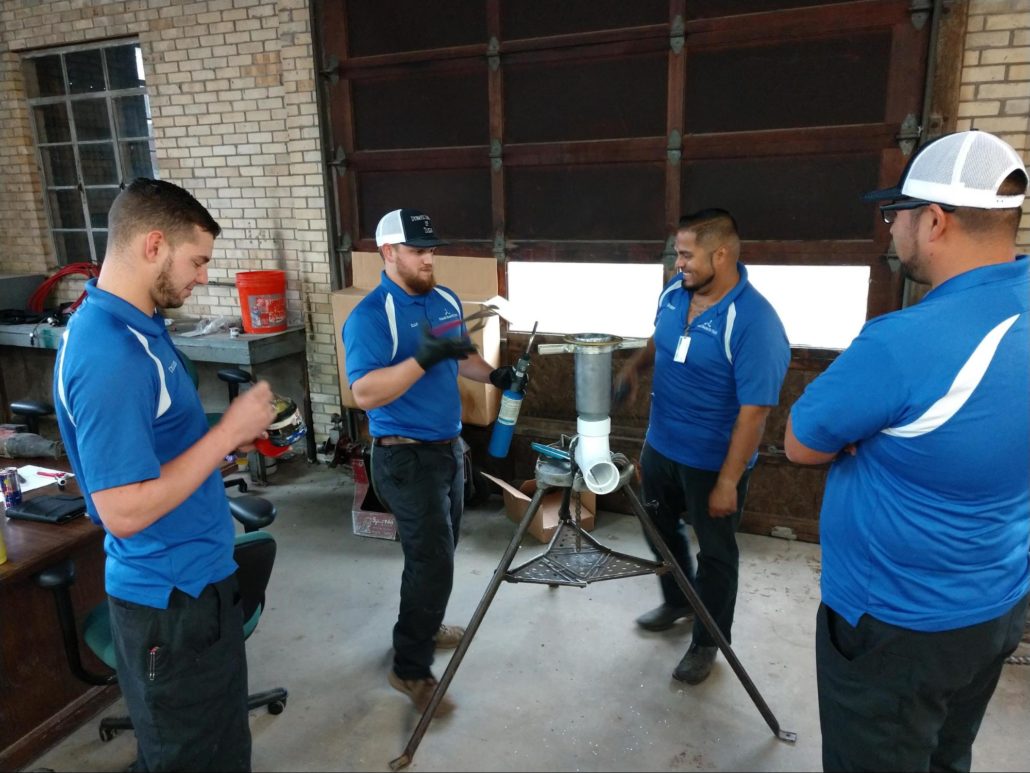The Scourge of Loose Toilets
Ok, maybe the title is a bit over dramatic, but the issue of loose toilets is one that gives us as repair plumbers a lot of grief AND a lot of work.
Why are so many toilets loose, especially in commercial settings? There are many reasons for this but often it is due to the type of connection for the toilet to the drain and the leveling of the floor the toilet is set upon, not to mention heavy use in public restrooms. Loose toilets can cause issues beyond the obvious one of rocking while in use. A loose toilet can cause leaks to occur at the seal and, depending on the severity, can be a potential hazard to someone who has limited mobility or difficulty in sitting down and standing up. A very common attempt to repair a loose toilet is to try and tighten the bolts on the side. This sometimes works but if the bolts are rusted, not set properly, or if the flange the toilet sets on is broken, tightening will not solve the issue. In this article, we will mainly discuss the most common type of toilet: a floor mounted toilet.
A common term used in this article is RISER. A riser, as it pertains to plumbing, is a vertical pipe that extends off of a horizontal pipe. A toilet riser is simply the vertical pipe that the toilet flange connects onto. The flange is the part that the bolts on the sides of the base connect to in order to attach the toilet to the drainage system. There are a couple different types of flanges for PVC drain pipes and a couple for cast iron pipes. For PVC, there are ones that are 100% plastic and ones that are mostly plastic but have a metal ring for the bolts. There is a transitional type of fitting for PVC drains that have a lead (the metal, not the position) riser that uses a brass soldered on flange, but this type is not as common on buildings with PVC drains. For cast iron drains, lead risers are common in the south but some older homes still have cast iron risers that use a different type of flange. In the end, all of them have the same purpose: to connect the toilet to the drain and assist in securing it to the floor.
Before we get too far into this, I would like to clear up a common misconception. The seal between the outlet of the toilet and the drain is primarily designed to keep from sewer gases escaping and minor amounts of water that can splash out. It is NOT designed to hold back water that can back up into a toilet in the event of a clogged sewer main. When a sewer line clogs up and a toilet is flushed, often the water leaks out at the base of a toilet. This happens because the wax seal at the base can only hold back so much before the water seeps through, even on a recently set toilet with a new wax seal. If this happens, it is a good idea to pull and reset the toilet after the clog has been cleared and replace the wax seal so that sewer gases and more water do not leak out. A side note: if a toilet leaks at the base due to a clog, that can indicate that the clog is not isolated to the leaky toilet but further down the line. If the clog is actually in the toilet, usually no leaks will occur at the base when the toilet fills up past the normal level.
First, let’s take a look at how a floor mounted toilet is set: After the sub-floor for a building is complete, that is when the flange that the toilet connects to is installed which is often before the finished floor is installed. The finished floor has a lot to do with how the setting of the toilet will go because different flooring materials have different thicknesses. For instance, vinyl flooring does not raise the floor up much at all compared to tile or carpet. Luckily, carpeted bathrooms have mostly gone out of style since the 1980s but some homes still have the original bathroom decor with carpet and a different process is involved for carpeted bathrooms. The most common flooring used for bathrooms are tile and vinyl. If the toilet flange was set before the final flooring is installed, then the height of the flange can end up being lower than it should. The correct way for a flange to be installed is directly on top of the finished floor like in the photos below, but this is not always the case when the floor is completed after the flange is attached. Often what we find is that the flange is flush with the finished floor and not directly on top. With this scenario, it can cause issues with how well the toilet sets and can cause leaks but is not a major issue to resolve.
Sometimes during the original installation of the plumbing, the measurements are off for the location of the toilet by a couple inches horizontally. In these cases, an offset flange can be used in lieu of breaking up a slab and relocating the riser. This, too, can cause issues if the installer is not familiar with the proper way to install the seal for an offset flange. After the flange is installed and the flooring is done, the final part of the project is setting the toilets with seals, and the most common type of seal is a soft wax ring. Each time a toilet is pulled and reset, the wax seal MUST be replaced because after setting the toilet, the wax has been pressed into the flange and onto the outlet of the toilet therefore it has a one time use. Once the seal has been placed on top of the flange, the base of the toilet can be set and anchored down. If carpet is used, then the carpet and carpet pad must be cut to the shape of the base of the toilet so it can be set solid. Carpeted bathrooms can make replacing a toilet difficult because the profile of the new toilet’s base is always different. If the carpet is cut again to fit the new toilet, it can leave noticeable gaps.
The purpose of the flange is to secure the toilet to the floor and drain. The floor has a lot to do with how solid the toilet will be once it is set. If the floor is level and the flange height is within tolerance, then the toilet can be set solid and level with a good seal. The bolts on either side at the base of the bowl are designed to affix the toilet to the flange and not necessarily designed to anchor the toilet to the floor solely. The bolts on the side of the base of a toilet are wide enough to withstand a certain amount of weight shifting but not enough to withstand too much beyond reasonable use by a normal sized adult. The floor has a lot to do with how solid a toilet is because the bolts pull the toilet to the flange but it is the floor that the toilet sets on that provides most of the stability. The gap between the flange and the bottom of the toilet should not be more than an inch. The flange is secured to the drain but it should also be secured to the floor in order to provide more stability and to independently secure it to the structure. The toilet riser and plumbing should not support the weight of the toilet solely. What we run into regularly when we have to replace a broken flange is the flooring around it is not sufficient enough to actually anchor the flange to the flooring, either due to partially rotten wood flooring or the concrete opening is too large to actually anchor the flange independently. When this happens, other measures must be taken in order to get the toilet secured, such as caulk around the base, fill in the void with hydraulic cement or, in more extreme cases, the flooring must be replaced in the area around the toilet. This happens when a leak has gone on for a long time causing the floor to rot out.
So what do you do with a somewhat unlevel floor in your bathroom? As you can see in the photo with the PVC offset flange, shims were used in order to compensate for the unlevel floor. We also find pennies or other coins of varying thickness used to level a toilet when official shims aren’t readily available. I will admit that I am guilty of using pennies to help level a toilet. The reason I bring up unlevel floors for a toilet is because so often, that is the direct cause of a loose toilet. Over time, shims can work themselves out and thus cause the toilet to rock. Sometimes that can be remedied easily enough with new shims...or pennies.
Another cause of loose toilets is corroded bolts. This usually happens after many years and can be a sign of a leak at the toilet seal. If a toilet’s seal is broken enough to leak just a little each time it is flushed, over time this can corrode the bolts due to the corrosive nature of sewer gases and water. You may wonder, “How does a brass bolt rust if it is brass?” That is because many of them are zinc coated bolts and not true brass, though brass can oxidize and corrode over time but not nearly as bad as zinc. If you notice the toilet is loose and the bolts show signs of rust, it is best to pull the toilet and inspect the flange for issues and replace the seal.
In my professional opinion, the most solid type flanges are the ones made of brass and installed on lead risers. The brass ones are soldered onto a lead riser and are much stronger than a PVC flange plus they will not corrode like some of the PVC flanges with metal rings. The main issue that a lead riser can present is the fact that it is lead, a fairly soft metal. If the lead is damaged or torn off below the level of the floor, the repair may require more invasive work such as breaking up the floor to replace the riser. This is not a common issue, in my experience. As you can see in one of the photos, we train on how to properly solder a new brass flange onto a lead riser because that is the best and correct method for replacing a broken brass flange. If a PVC flange is required, the ones with the stainless steel metal ring are the best option, if available. The PVC flanges with a red or blue metal ring are not stainless steel and rely on a painted on coating to protect the metal. As long as there is no leak, the coating will last a long time.
The most common cause of a loose toilet is due to a broken flange. The 100% PVC flanges with the plastic ring, as seen in a couple photos here, are very common to break because they rely on thin plastic to hold the toilet down and often the bolts are over tightened and snap the plastic ring upon the initial installation. They are code approved but not Dynamic Drains approved. I have seen my fair share of correctly installed PVC flanges that are not that old but have already snapped at the point where the bolt connects. We always replace those with flanges that have metal rings. I do not recommend letting a handyman or novice make this repair due to the nature of these repairs and how much can go wrong. Having an experienced repair plumber with the right tools that offers a warranty like we do to make the repair is the best option for peace of mind, not to mention that it is illegal for an unlicensed contractor perform plumbing work for a customer.
If an offset flange is existing and a toilet is to be set on it, make sure to have a plumber experienced in how to properly set toilets on these as we find many that have been improperly set and cause regular clogs or slow leaks that can result in a lot of damage over time. See photo below of an example of an offset flange that was causing clogs regularly at a restaurant due to being improperly set by a different plumber before our plumbers discovered the actual cause of it and reset the toilet correctly.
What if you are replacing the floor in your bathroom? Is resetting the toilet a difficult task and should you hire a plumber to perform the work as opposed to a handyman or flooring contractor? The answer is an unequivocal yes, hire a licensed plumber. Removing the toilet may be simple enough for a novice, but when it comes time to reset the toilet, there are a lot of factors to take into consideration that an experienced licensed plumber will know to account for, such as floor level, floor height, especially if the new floor is tile and the old was vinyl. In fact, it is an even better idea to have a plumber remove the toilet before the flooring is installed in order to see if any hidden issues are present before getting the floors installed. Even if the contractor or the property owner is confident in their ability, there are a lot of things that an experienced plumber would catch that a novice may not. It is always better to be proactive vs. reactive. Just because a new floor is thicker than the old floor does not mean the correction will be invasive. There are a lot of great products available to correct this that don’t require major work.
In conclusion, there are a lot of causes of loose toilets outlined in this article and many can be corrected by using a licensed plumber who has the necessary experience in repair work to properly fix it for good.
*************************************************************************************************************
A PVC offset flange where the toilet was improperly set and causing regular clogs at a restaurant. As you can see, shims were used to help to level the toilet. These flanges are ok, if the toilet is installed correctly.
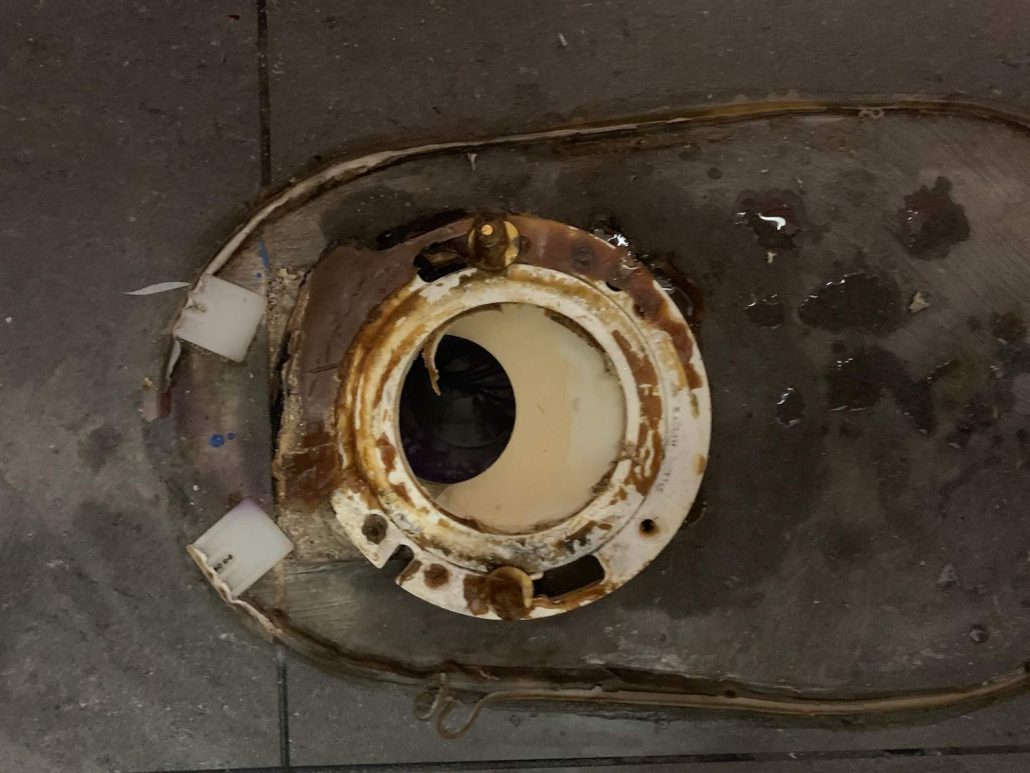
This is after cleaning up the old lead riser right before installing a new brass flange:
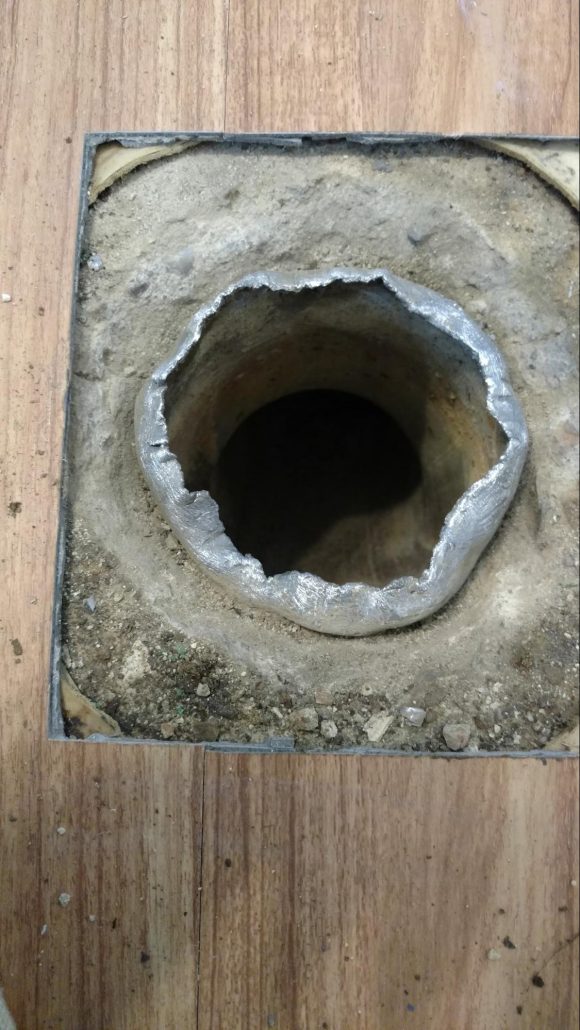
A brass flange installed onto a lead riser. I installed concrete anchors after the photo was taken:
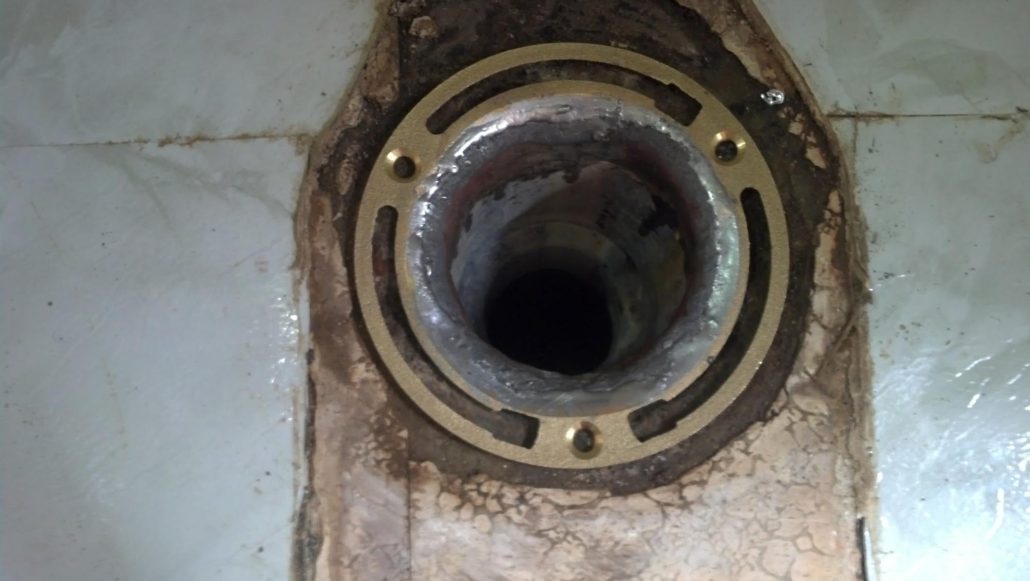
************************************************************************************************************
Before, during, and after of a replacement of a typical broken PVC flange with a plastic ring.
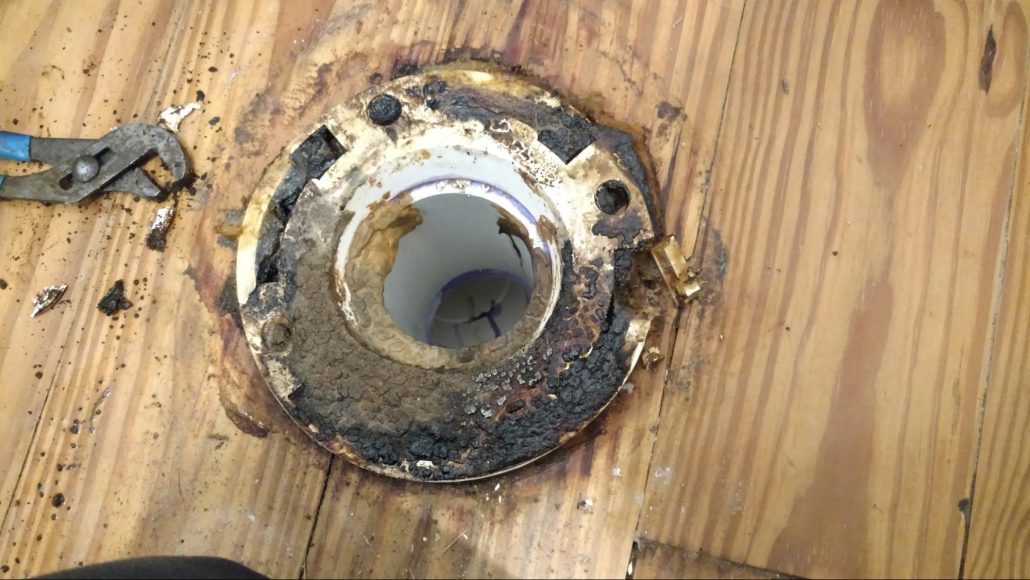
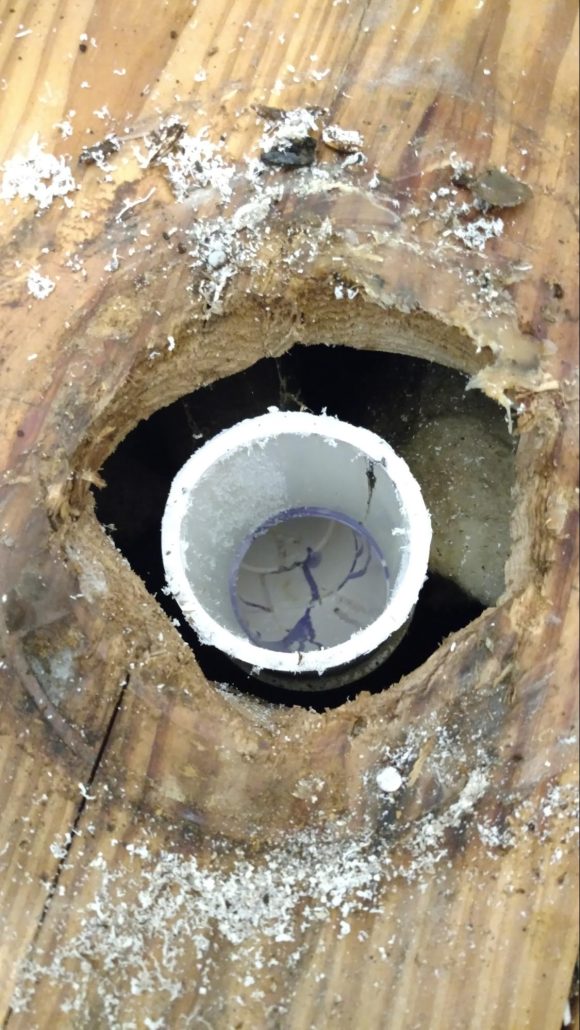
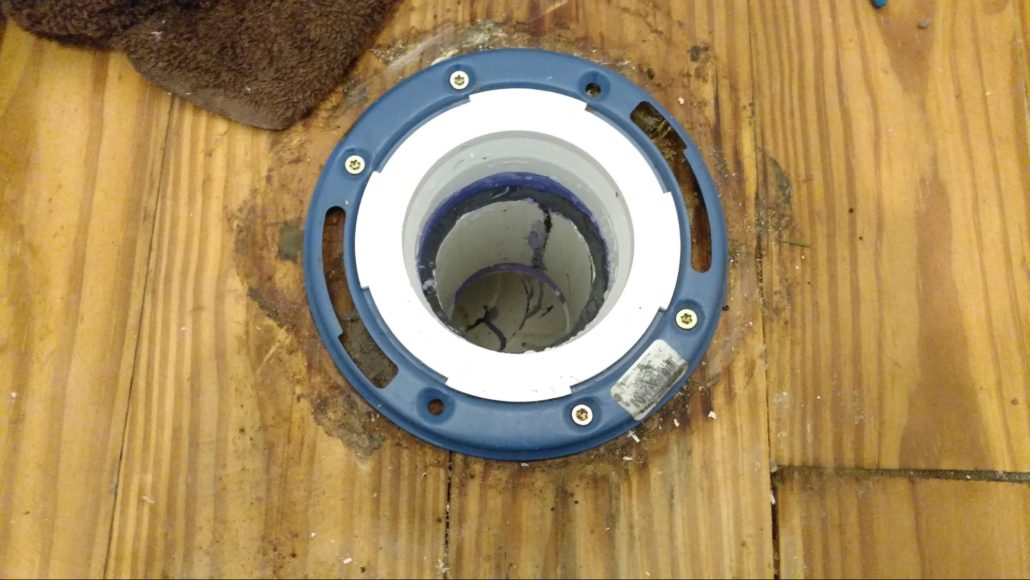
This is after the old flange was cut out. No, I did not cut that hole through the floor, it was like that already.
The new flange is in and anchored to the floor. As you can see, the top of the flange is on top of the floor, as it should be.
************************************************************************************************************
Training on how to properly install a brass flange on to a lead riser. Unfortunately, we do not typically have the luxury of doing this job in our shop in a controlled setting like in this photo.
